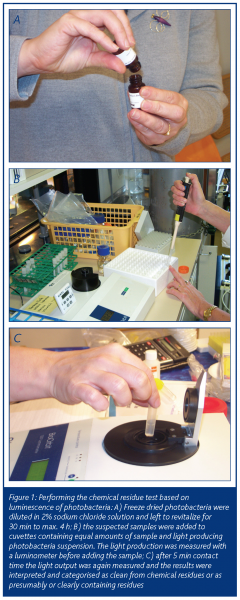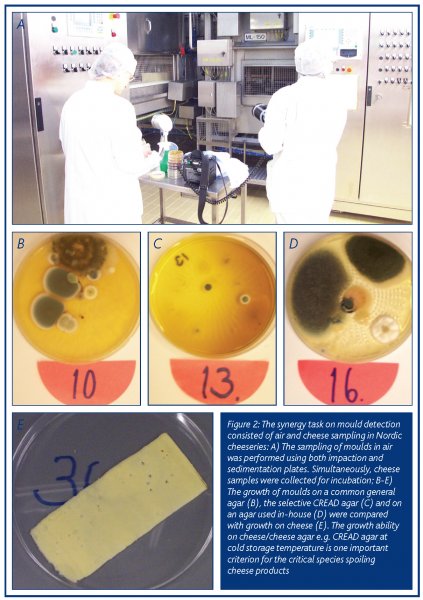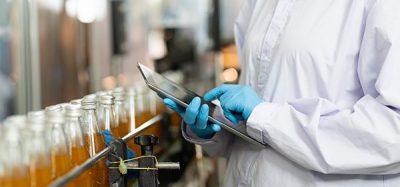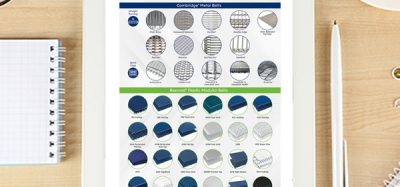Fruitful improvements in dairy hygiene
- Like
- Digg
- Del
- Tumblr
- VKontakte
- Buffer
- Love This
- Odnoklassniki
- Meneame
- Blogger
- Amazon
- Yahoo Mail
- Gmail
- AOL
- Newsvine
- HackerNews
- Evernote
- MySpace
- Mail.ru
- Viadeo
- Line
- Comments
- Yummly
- SMS
- Viber
- Telegram
- Subscribe
- Skype
- Facebook Messenger
- Kakao
- LiveJournal
- Yammer
- Edgar
- Fintel
- Mix
- Instapaper
- Copy Link
Posted: 29 July 2005 | Gun Wirtanen and Satu Salo, VTT Biotechnology, Espoo, Finland | No comments yet
The project ‘DairyNET – Hygiene control in dairies’ was built both on common synergy tasks performed in all Nordic countries and on national research studies. The synergy tasks dealt with rapid detection of cleaning agents and disinfectants residues, detection of organic soil in processing equipment hot spots and detection of moulds contaminating cheese. The national research dealt with a checklist for hygiene control; milk quality through the whole process line; air quality; contamination routes for Listeria; quality of process waters; efficiency of CIP procedures; hygiene in supply systems; ultrasound cleaning procedures; bacterial resistance to disinfectants; hygienic design and integrated hygiene systems.
The project ‘DairyNET – Hygiene control in dairies’ was built both on common synergy tasks performed in all Nordic countries and on national research studies. The synergy tasks dealt with rapid detection of cleaning agents and disinfectants residues, detection of organic soil in processing equipment hot spots and detection of moulds contaminating cheese. The national research dealt with a checklist for hygiene control; milk quality through the whole process line; air quality; contamination routes for Listeria; quality of process waters; efficiency of CIP procedures; hygiene in supply systems; ultrasound cleaning procedures; bacterial resistance to disinfectants; hygienic design and integrated hygiene systems.
The project ‘DairyNET – Hygiene control in dairies’ was built both on common synergy tasks performed in all Nordic countries and on national research studies. The synergy tasks dealt with rapid detection of cleaning agents and disinfectants residues, detection of organic soil in processing equipment hot spots and detection of moulds contaminating cheese. The national research dealt with a checklist for hygiene control; milk quality through the whole process line; air quality; contamination routes for Listeria; quality of process waters; efficiency of CIP procedures; hygiene in supply systems; ultrasound cleaning procedures; bacterial resistance to disinfectants; hygienic design and integrated hygiene systems.
Building blocks in DairyNET
Co-operation between dairies and research institutes in the Nordic countries has been established between 1994 and 2004 in three consecutive 3-year projects: Sanitation in dairies, Evaluation of cleaning chemicals used in dairies and DairyNET. During this chain of projects a solution to one case has raised new questions and led to further research. Improvements in hygiene systems are important due to developments in the food industry; for example, prolonged product shelf-life; centralised production and long-distance transportation; automated cleaning systems; reduced cleaning time and demands for environmentally friendly cleaning agents. One aim of this co-operation was to ensure that the detection and identification methods developed and applied in assessing microbial and organic soil on surfaces, in the air, on packages, in raw materials and in products in process scale in dairies give reliable and repeatable results. Another aim was to extend the Nordic dairy hygiene platform.
The number of project partners taking part in subsequent projects has increased during the programme. The dairies involved in the latest project were Arla Foods from Sweden and Denmark; Milko, Norrmejerier and Skåne mejerier from Sweden; Nordurmjolk from Iceland; TINE from Norway and Valio Ltd from Finland. The other six enterprises representing equipment manufacturers, cleaning agent producers and diagnostic firms were Finnsonic Oy, JohnsonDiversey, Lagafors Fabriks AB, Mjöll, Orion Diagnostica Oy and Tetra Pak Nordic Processing. The research work was mainly carried out at the following Nordic research institutes: the Danish Technological Institute, the Icelandic Fisheries Laboratories, Matforsk, SIK and VTT Biotechnology. The universities BioCentrum-DTU, the Royal Institute of Technology and University of Akureyri were also involved.
From an industrial point of view it is very important to maintain and extend the interactive contact between people dealing with safety and environmental questions in Nordic countries. The DairyNET-project was carried out in both the national projects and the Nordic synergy tasks. Dr Gun Wirtanen from VTT Biotechnology has been the coordinator of these projects and they have been mainly funded by the Nordic Innovation Centre (NICe; formerly the Nordic Industrial Fund). Funding has also been available from the national technology agencies in Denmark, Finland, Iceland and Sweden as well as the project partners. The six examples in knowledge exchange – two Nordic synergy tasks and four national research studies – describe the project well. Further reading about the project can be found in the DairyNET-book (www.vtt.fi/inf/pdf/publications/2004/P545.pdf).
Synergy task on residue testing of disinfectants
Disinfection is used to reduce the number of microbes on food-contact surfaces. When the disinfection process fails this can, in most cases, be explained by the use of a disinfectant with too low a concentration; too short exposure time; wrong temperature or failure in the cleaning process. However, residues of disinfectants are not accepted. The current status is that there is no official method that is quick and sufficiently sensitive to detect chemical residues on food contact surfaces before starting food processing in a cleaned process line.
A residue assessment method based on the luminescence output of photobacteria was taught to all project partners and was used in dairies for detecting residues of disinfectants on food processing surfaces before the start-up of production. The steps of this method are described in Figure 1. One advantage of this new method is its rapidity. Its sensitivity was also found to be much better than the method based on inhibition zones, which is based on growth and is therefore slow due to disinfectants in inoculated agar. This study showed that chemical residues are left on surfaces in very many cases prior to production. This method offers a useful alternative for testing the chemical residue on surfaces.
Synergy task on mould contamination in cheesery
Good experience in the synergy task on residue testing was followed up by a new synergy task on cheese contaminating moulds. Mould on semi-hard cheese is periodically a significant quality problem with financial consequences for cheese producers. Most of the fungi found in the hygiene surveys performed in the internal environment of cheeseries have not been found to contaminate the cheese products. The selective CREAD agar, together with a general agar medium for the isolation of moulds, was tested in order to obtain data on moulds in the environment and to find out if CREAD agar can be used in discrimination of moulds contaminating cheese. Materials and methods used in this synergy task are shown in Figure 2. The results showed that moulds growing on CREAD agar are those found on contaminated cheese. It is advisable to test identified critical species for growth on the CREAD agar in order to know how to interpret the mould growth. A third synergy task dealing with detection of organic soil with ultraviolet light was also performed in all Nordic countries. Comparison of common results at meetings enhanced the understanding of the methods discussed between project partners.
Hygiene mapping in Estonian dairies
This study was performed to find critical points in which contamination might occur in the process. Samples were taken from both food contact and non-contact surfaces of the equipment; raw materials; packaging materials; waste and process waters; products under processing; final products and the environment e.g. floors and hoses. The samples in this hygiene survey were taken with commercially available Hygicult (TPC, E/β-GUR and Y&F) and Rida Count (total bacteria count, yeast/mould and coliform) contact agars and with moistened gauzes that were soaked in peptone saline diluent in the laboratory in order to make further cultivations for detecting pathogens (Listeria monocytogenes, Bacillus cereus and Mycobacterium spp.). The degree of fouling and the location of problem areas varied between the three dairies investigated. Some common problem areas were observed on floors and flat surfaces in the packaging areas, in hoses and cleaning tools. These results showed that food contact surfaces were mostly clean from microbes, but that the non-contact equipment surfaces were often contaminated with aerobic bacteria and also enterobacteria and fungi. Sampling of enterobacteria with contact agar gave a good indication of contamination as a routine hygiene control method and in most cases it also correlated well with the aerobic bacterial counts obtained on surfaces. The aerobic bacterial count for one of the six packaging material samples studied was above the recommended level. Furthermore, the presence of pathogens was minor both on the surfaces and in product samples. L. monocytogenes was isolated from two raw milk samples and B. cereus was isolated from one powder that was used as a raw material. Our results showed that the products under processing and final products were neither contaminated with B. cereus nor with L. monocytogenes. Mycobacteria were found in 13 out of 33 samples (39.4 per cent) taken from the environment, equipment, end product, water and products under processing. As mycobacteria are widely distributed in the natural environment and natural water, there are many potential sources of contamination through which mycobacteria can infiltrate dairies. Dairies should therefore pay more attention to the control of mycobacteria as some of them are pathogenic.
Listeria contamination routes for milk on Iceland
The Icelandic part of the project focused on contamination routes of Listeria. L. monocytogenes, which can be transmitted by the consumption of raw milk products or contaminated dairy products. The situation in the dairy industry is slightly different to other food sectors, because the milk is pasteurised. It is thus reasonable to conclude that dairy products become contaminated with Listeria somewhere along the process line. In this survey, no positive Listeria samples were observed from the 450 samples taken in the factory environment, from process equipment and selected dairy products. However, L. monocytogenes was detected in 13 samples of raw milk (1.5%). This is in the same range as previously reported from Western Europe and the USA. L. monocytogenes isolates were traced from raw milk and shed environment samples at the farm that was positive for all three winter-sampling occasions. In this investigation, all generated ribotypes were identical to the L. monocytogenes patterns available except for one ribotype; L. seeligeri. It has been confirmed that L. monocytogenes can persist for long periods establishing an in-house flora. Additionally, it is interesting to note that there seems to be a seasonal variation concerning the occurrence of L. monocytogenes from raw milk. A reasonable explanation for this is contamination from the shed environment and contaminated silage during wintertime caused when animals are kept relatively close together for long periods.
Survey of waterborne contamination in Swedish dairies
A sampling plan for water, air, surfaces and cheese was established in the Swedish project in order to perform hygiene surveys properly. It was stated that the sampling points should be randomly selected and not prejudiced by what are believed to be likely problems. The results demonstrated that there is a possibility of waterborne contamination in the processing plants due to insufficient hygiene and maintenance of water sources – e.g. hoses, nozzles and taps. The sources of contaminants could be revealed through characterisation of microbes. Product-related sampling should also be carried out on products when water is suspected to cause problems. The analyses to be carried out should be selected on the basis of the type of problem being experienced. The microbes most likely to become established in these environments are bacteria such as Acinteobacter spp. and Pseudomonas spp.; yeasts such as Candida spp. and Rhodotorula spp. and moulds such as Phoma spp. and Fusarium spp. Penicillium spp.. Each were rarely isolated from water. Positions with increased contamination were detected by sampling water sources. At two plants, several contaminated water sources used for cleaning were detected. It was also shown in both the Swedish and the Finnish national projects that air sampling can be used for the identification of process positions contributing to improper hygiene.
Norwegian study of microbial ecology in ice waters
Ice water in dairies is used to cool milk and products in plate heat exchangers, tank walls and agitators. Ice water, which can be microbiologically contaminated, may leak into the product in tanks, agitators and plate coolers if the pressure is not controlled. Ice water samples were collected from 42 dairies in Norway from October to November 2004 in order to check its quality. Thirty dairies gave further information on the type of ice water system; equipment in which ice water was used; temperatures, cleaning of the system; use of chemicals to treat the ice water; sampling of ice water; type of incoming water used for ice water preparation and whether direct glycol cooling was used in their systems. Standard microbial water analysis based on total microbial count at 22°C, coliforms, E. coli, intestinal enterococci and C. perfringens were performed. In spring 2004, ice water samples from 13 dairies, in which high total aerobic counts had been found in autumn 2003, were collected for analysis of L. monocytogenes in addition to a check-up of the total aerobic and coliform counts. L. monocytogenes was not detected in any of the samples using 1000 ml in the enrichment. The results from the sampling showed that the aerobic microbial level in most cases was more than 100 cfu/ml and less than 30,000 cfu/ml – with a few cases having a lower count than 100 cfu/ml ice water. In most of the dairies neither the hygiene indicators nor pathogens checked were found. Drinking water legislation recommends that the total aerobic count should be 100 cfu/ml. Furthermore, coliforms, E. coli, intestinal enterococci and C. perfringens should not be detected in 100 ml. In the retest carried out in November 2004 eight dairies sent in new samples. These results showed coliforms in two cases.
Furthermore, UHT-milk was inoculated with 0.1% ice water and incubated for 5 days at 6°C to study the potential growth of psychrotropic microbes. These samples were analysed for total aerobic count, coliforms, Pseudomonas spp. and Aeromonas spp. The results showed that in 11 cases there was no growth, in 17 cases a growth from < 1 – 4 log units was found and in the rest the growth exceeded 5 log units. The ice water system is a quality risk and leakage in the systems must be prevented so that it cannot contaminate the product. The system should also be checked visually when the microbial sampling is carried out.
Conclusions
New procedures in the hygiene concept based on the project findings have been implemented in processing – for example, in planning hygiene surveys and applying suitable methods in the hygiene surveys. The co-operation in these projects has shown that knowledge in sampling, interpretation of results and improving actions is gained when performing similar hygiene surveys and sharing experience with other dairies.
Acknowledgements
We are grateful to the Nordic Innovation Centre for funding the DairyNET-project. The DairyNET-book contributors and other project participants are warmly acknowledged for their input in the DairyNET-project.






References
Wirtanen, G. & Salo, S. (eds.) 2004. DairyNET – Hygiene control in Nordic dairies. VTT Publication 545. Espoo: Otamedia Oy. 253 p + 63 p. ISBN 951 38 6408 1.
Wirtanen, G. & Salo, S. 2005. Improper dairy hygiene – Case studies on poor microbial ecology in the Nordic DairyNET project. In: The 36th R3-Nordic Symposium & the 5th European Parenteral Conference of ESPC in Linköping May 23-25, 2005. Pp. 171-182.
Wirtanen, G., Langsrud, S., Salo, S., Olofson, U., Alnås, H., Neuman, M., Homeid, J.P. & Mattila-Sandholm, T. 2002. Evaluation of sanitation procedures for use in dairies. VTT Publication 481. Espoo: Otamedia Oy. 96 p + app. 43 p. ISBN 951-38-6017-5.







